The unique question mark appearance of M51, its size (77 thousand light years, 90% of Milky Way) proximity to us (only 31 million light years) made it a galaxy of interest for me, so I brought it in for some serious cross examination. The story it tells is very interesting and revealing.

M51, NGC 5194 – Whirlpool Galaxy – Question Mark Galaxy and Companion Galaxy NGC5195
Planewave CDK 12.5in; AP 1100GTO AE; QHY600M, – Antlia Broadband and 3.5nm Ha Filters
L: (48 x 180s, Bin 1, Gain 100); H: (28 x 720s Bin 1, Gain 100); R,G,B: (28,21,24 x 210s, Bin 1, Gain 100)
Total integration time = 12.3 hrs (Apr2,3, 2025) Maple Bay, BC, Canada
For full resolution images and downloads, please link to the Victoria RASC Zenfolio site or Astrobin. Then come back to learn all about it.
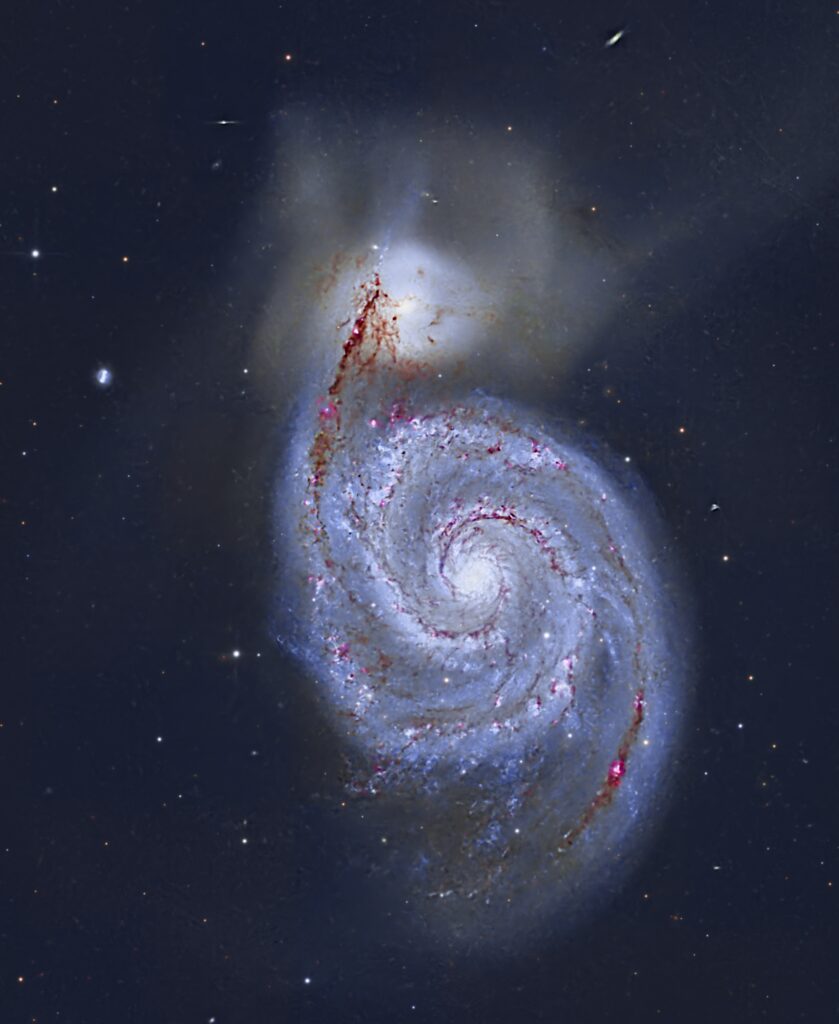
The size and proximity of the Whirlpool Galaxy allow it to reveal to us a lot of its structure with this close-up. Very simply there are actually two galaxies interacting with each other – exerting gravitational tidal forces on each other and potentially orbiting each other. A great summary of M51 is available on Wikipedia.
The larger galaxy (NGC NGC5194 or shortform, “4”) is a spiral galaxy displaying all its jewelry – dark brown dust lanes, Ha emission zones in the spiral molecular clouds, and of course stars – predominantly large, hot blue ones. The lack of yellow-orange-red stars suggests that 4 is a fairly young galaxy (about 400 million years) and despite its size being only 90% that of the Milky Way, it only contains about 10% of the mass of stars. There are plenty of emission zones in the well defined arms suggesting 4 is trying to catch up to the Milky Way, though, throughout its radius.
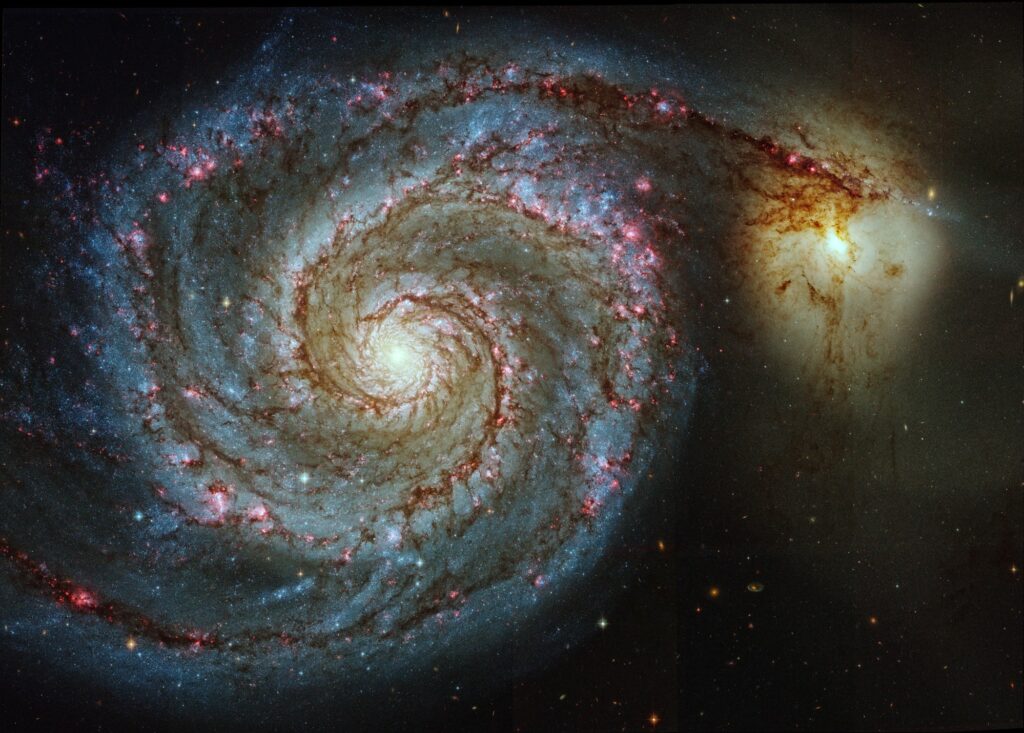
In this Hubble telescope image (credit Chandra website), we can see even more details on both the 4 galaxy and HGC5195 (or “5” for short). 5 is not a spiral galaxy like 4, but rather it is likely a much older elliptical galaxy containing much older, longer lived yellow/red/orange stars – the blue ones having long died or evolved their colour. 5 is still oblate reflecting either or both its past as a disk or spiral galaxy and its close encounter(s) with 4.
Currently the 5 galaxy lies behind or further away from 4, and backlights one of the spiral arms (the upper one in my image). This backlighting really helps us see many of the details of the dust & the molecular cloud that carries it. It appears that the tidal (gravitational) interaction is currently weak on this dust lane. Because we don’t have a 3-D view of the arm, I can’t really tell how much, if any, the dust lane / arm is bending into the page towards 4, but it looks fairly intact – particularly compared to what exists to the opposite arm (bottom of my closeup) on 4 – more on this later. I would say that the current state of tidal interaction between the two galaxies is weak. None the less, 5 looks like it contains some molecular cloud vestiges that it has either stolen from 4, or may simply be backlighting them.
Three plumes of stars appear to be erupting from galaxy 5, away from 4. However, a closer look reveals that the middle one is bluer, and is in reality an extension of 4’s spiral arm. There is little dust evident in this arm extension, but whether it also contains diatomic hydrogen or not would just be a guess on my part. The other plumes are yellower and therefore older either formed from 5’s own older stars or evolved blue stars stolen from 4.
Putting on my detective’s hat, I am surmising that galaxy 5, once upon a time, interacted with the spiral 4 much more strongly, judging from the much poorer state of the other arm in 4. It looks as if this arm, on the opposite side of 5’s current position was roughly amputated, leaving behind a mess of green stuff – dispersed dust and only stars behind. If the interaction is true, it would mean that at, some time galaxy 5 was closer to, but on the opposite side of 4 – where tidal forces were causing some real damage to both galactic structures.
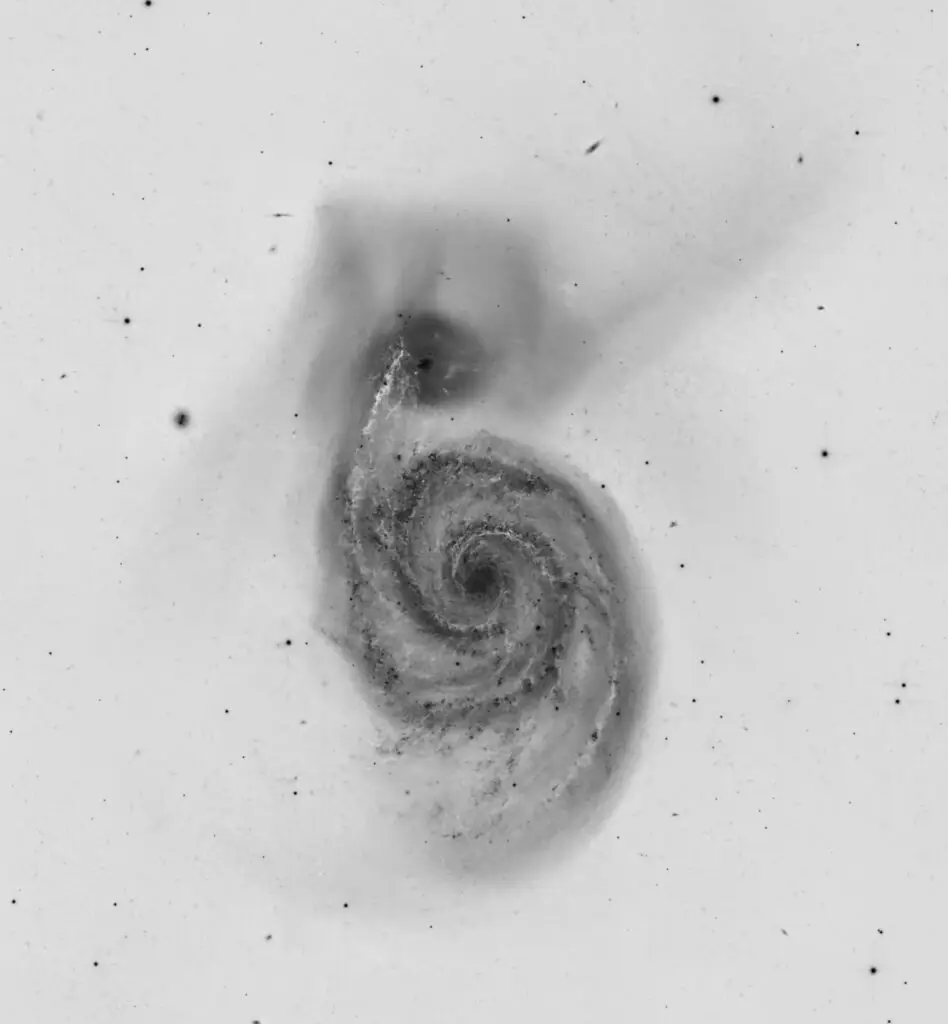
Evidence for the relative trajectory of 5 around 4 can be obtained by looking at an inverted luminance image that shows a trail of stellar breadcrumbs leading from 5 back to the far spiral arm of 4. I think this enough to convict 5 of the crime of assault on the far arm of 4. After the assult, 5 must have travelled clockwise and behind 4 to arrive at its current position, leaving behind this fog-like trail of stars in its wake.
Curiously there is another breadcrumb trail leading off to the right of 5. I am not sure what this star trail is, but it could be a vestige of a previous or previous assault, or counter tidal effects perpetrated on 5 from 4 itself.
And yet, there is still more that we can learn from this intergalactic interaction. If you have read my postings on spiral galactic structure, you will know that I believe that most of the dust in a galaxy is held in suspension in the molecular clouds (diatomic hydrogen molecules) that form the spiral arms of the galaxy. At a galactic scale, the dust can act as a tracer for where the molecular clouds are, because diatomic hydrogen is, by itself, invisible. The molecular clouds exhibit the behavior of a continuous fluid – particles held together by viscous and electromagnetic forces (Van der Waal, London, dipole) in addition to gravity. Dust, through dispersion chemistry, does alter the properties of the molecular cloud itself depending upon its concentration and make-up, There is a materiality or cohesion to the molecular clouds as if they had a sort of surface tension when hydrogen is in this diatomic phase or state. Consequently, dust and molecular clouds tend to be found as coherent strands – both within the galaxy itself and even when molecular clouds are poached from one galaxy to another.
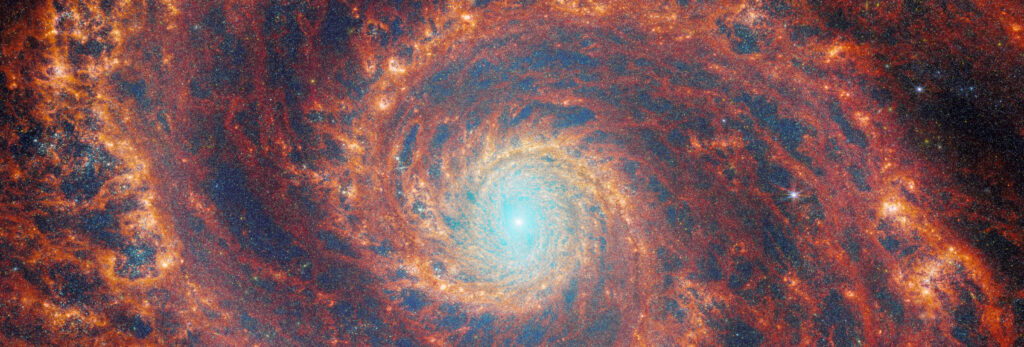
In this infrared JWST image (Credit ESA), the position of dust, and by proxy, molecular clouds within galaxy 5 is revealed. There are definite strands of molecular cloud both forming the arms. It’s presence is definitely binary, however, with also definite holes and gaps between the spiral arms.
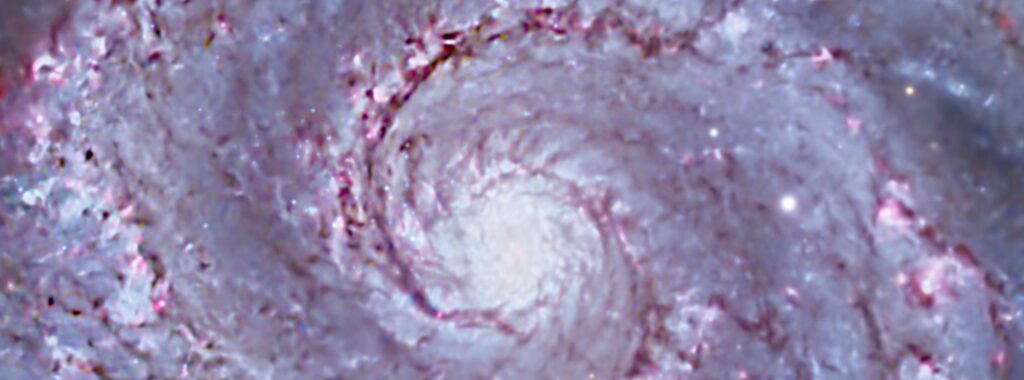
The strands of molecular clous are also visible, but to a lesser degree in my image of the same area within M51. In the holes and gaps there is little dust, only stars (less prominant in visible light), and monatomic hydrogen ISM.
Stars and even monatomic hydrogen, exist as almost independent particles – subject to gravitational and inertial forces only. They can be found, just like in our evidential star trail, at a spectrum of concentrations of these particles. Molecular clouds, on the other hand, exist as a thermodynamic state or condition and behaves more like a collective – retaining their integrity even when pulled around by tidal forces. We can see that in relief when backlit by galaxy 5.
One final remark before releasing M51 from its interrogation, is that in my visible light image, we cannot make out the black hole that exists within the molecular cloud donut hole at the centre of the galaxy. In this galaxy it is obscured by dust (not within a molecular cloud) and stars. In contrast, the JWST IR image shows the central black hole as the brightest point in the image.

Fantastic work Dave! Your narrative is so interesting.
Thanks Ron, Glad you found it interesting.